Damping Analysis of High Damping MgO/Mg Composites in Anelastic and Microplastic Deformation
Abstract
1. Introduction
2. Experimental
2.1. Preparation of Samples
2.2. Characterization of Materials
3. Results and Discussion
3.1. Microstructure Analysis of MgO/Mg Composite
3.2. Anelastic Damping of MgO/Mg Composites
3.3. Microplastic Damping Mechanism of the Phase of MgO/Mg Composites
4. Conclusions
- (1)
- In this study, a new biphasic magnesium oxide/magnesium composite was prepared using in situ oxidation. The damping properties of the in situ-oxidized MgO/Mg composite were greatly improved compared to pure magnesium.
- (2)
- In the anelastic damping of the composites, the dislocation lines rid themselves of weak pinners and start to oscillate between strong pinners. The damping performance of the composites increases with the increase in strain amplitude. The in situ-synthesized oxide particle effectively enhances the damping capacity of the magnesium matrix.
- (3)
- In the microplastic deformation of the composite, there are other damping mechanisms inside the composite that are different from the dislocation damping mechanism. The increase in the number of interfaces causes an increase in the interfacial damping contribution, which enhances the damping properties of MgO/Mg composites at high strain amplitudes.
Author Contributions
Funding
Data Availability Statement
Conflicts of Interest
References
- Zhang, Z.; Guo, Y.; Zhao, Y.; Chen, G.; Wu, J.; Liu, M. Effect of reinforcement spatial distribution on mechanical properties of MgO/ZK60 nanocomposites by powder metallurgy. Mater. Charact. 2019, 150, 229–235. [Google Scholar] [CrossRef]
- Wang, X.; Wu, W.; Tang, Y.; Zeng, X.; Yao, S. Early high temperature oxidation behaviors of Mg-10Gd-3Y alloys. J. Alloys Compd. 2009, 474, 499–504. [Google Scholar] [CrossRef]
- Song, J.; She, J.; Chen, D.; Pan, F. Latest research advances on magnesium and magnesium alloys worldwide. J. Magnes. Alloys 2020, 8, 1–41. [Google Scholar] [CrossRef]
- Hu, X.; Zhang, Y.; Zheng, M.; Wu, K. A study of damping capacities in pure Mg and Mg-Ni alloys. Scr. Mater. 2005, 52, 1141–1145. [Google Scholar] [CrossRef]
- Ramalingam, V.V.; Ramasamy, P.; Das Kovukkal, M.; Myilsamy, G. Research and Development in Magnesium Alloys for Industrial and Biomedical Applications: A Review. Met. Mater. Int. 2020, 26, 409–430. [Google Scholar] [CrossRef]
- Wan, D.; Dong, S.; Hu, Y.; Hu, J.; Xue, Y.; Han, G. Strain Amplitude Dependence of High Damping Grp/Mg97Zn1Y2 Composites Ranging from Anelastic to Microplastic. Metals 2021, 11, 1570. [Google Scholar] [CrossRef]
- Lin, L.; Liu, Z.; Chen, L.; Liu, T.; Wu, S. Microstructure evolution and low temperature superplasticity of ZK40 magnesium alloy subjected to ECAP. Met. Mater. Int. 2004, 10, 501–506. [Google Scholar] [CrossRef]
- Huang, Z.; Qi, C.; Yang, G.; Lai, H.; Zhu, Y.; Zhi, C. Effect of Stress State in Rolling Deformation Zone of AZ31 Magnesium Alloy Plate on Edge Cracking. J. Mater. Eng. Perform. 2020, 29, 3906–3912. [Google Scholar] [CrossRef]
- Srikanth, N.; Zhong, X.; Gupta, M. Enhancing damping of pure magnesium using nano-size alumina particulates. Mater. Lett. 2005, 59, 3851–3855. [Google Scholar] [CrossRef]
- Popov, A.; Shirmane, L.; Pankratov, V.; Lushchik, A.; Kotlov, A.; Serga, V.; Kulikova, L.; Chikvaidze, G.; Zimmermann, J. Comparative study of the luminescence properties of macro- and nanocrystalline MgO using synchrotron radiation. Nucl. Instrum. Methods Phys. Res. Sect. B Beam Interact. Mater. At. 2013, 310, 23–26. [Google Scholar] [CrossRef]
- Nikiforov, S.; Kortov, V.; Petrov, M. Luminescent and dosimetric properties of ultrafine magnesium oxide ceramics after high dose irradiation. Radiat. Meas. 2016, 90, 252–256. [Google Scholar] [CrossRef]
- Baubekova, G.; Akilbekov, A.; Feldbach, E.; Grants, R.; Manika, I.; Popov, A.; Schwartz, K.; Vasil’Chenko, E.; Zdorovets, M.; Lushchik, A. Accumulation of radiation defects and modification of micromechanical properties under MgO crystal irradiation with swift 132Xe ions. Nucl. Instrum. Methods Phys. Res. Sect. B Beam Interact. Mater. At. 2020, 463, 50–54. [Google Scholar] [CrossRef]
- Cui, Y.; Li, Y.; Sun, S.; Bian, H.; Huang, H.; Wang, Z.; Koizumi, Y.; Chiba, A. Enhanced damping capacity of magnesium alloys by tensile twin boundaries. Scr. Mater. 2015, 101, 8–11. [Google Scholar] [CrossRef]
- Wu, Z.; Wang, J.; Wang, H.; Ma, S.; Huang, S.; Li, S.; Pan, F. Enhanced damping capacities of Mg–Ce alloy by the special microstructure with parallel second phase. J. Mater. Sci. Technol. 2017, 33, 941–946. [Google Scholar] [CrossRef]
- Fan, G.; Zheng, M.; Hu, X.; Wu, K.; Gan, W.; Brokmeier, H.G. Materials Science and Engineering: A; John Wiley & Sons: Hoboken, NJ, USA, 2013; Volume 561, pp. 100–108. ISSN 0921-5093. [Google Scholar] [CrossRef]
- Wang, C.-J.; Deng, K.-K.; Liang, W. High temperature damping behavior controlled by submicron SiCp in bimodal size particle reinforced magnesium matrix composite. Mater. Sci. Eng. A 2016, 668, 55–58. [Google Scholar] [CrossRef]
- Malakar, C.; Trishul, M. Experimentation and optimisation of wear parameters of glass fibre-graphite reinforced composite. Mater. Today 2020, 27, 1431–1434. [Google Scholar] [CrossRef]
- Wan, D.; Hu, J.; Wang, H.; Hu, Y.; Li, L. Ultra-High Damping Capacity of Oxide Reinforced Magnesium Matrix Composites by In Situ Synthesis. Met. Mater. Int. 2021, 27, 5399–5406. [Google Scholar] [CrossRef]
- Hu, Y.; Deng, J.; Pan, F.; Zhang, D.; Chen, Y.; Wang, J. Study on damping capacity of graphite particle—Reinforced AZ31 magnesium matrix composites. J. Compos. Mater. 2020, 45, 557–564. [Google Scholar] [CrossRef]
- Ghanbari, A.; Jafari, H.; Ghasemi, F.A. Wear Behavior of Biodegradable Mg-5Zn-1Y-(0-1)Ca Magnesium Alloy in Simulated Body Fluid. Met. Mater. Int. 2020, 26, 395–407. [Google Scholar] [CrossRef]
- Wu, Y.; Wu, K.; Deng, K.-K.; Nie, K.B.; Wang, X.; Zheng, M.; Hu, X. Damping capacities and microstructures of magnesium matrix composites reinforced by graphite particles. Mater. Des. 2010, 31, 4862–4865. [Google Scholar] [CrossRef]
- Wu, Y.; Wu, K.; Deng, K.-K.; Nie, K.B.; Wang, X.; Hu, X.; Zheng, M. Damping capacities and tensile properties of magnesium matrix composites reinforced by graphite particles. Mater. Sci. Eng. A 2010, 527, 6816–6821. [Google Scholar] [CrossRef]
- Madeira, S.; Carvalho, O.; Carneiro, V.; Soares, D.; Silva, F.; Miranda, G. Damping capacity and dynamic modulus of hot pressed AlSi composites reinforced with different SiC particle sized. Compos. Part B Eng. 2016, 90, 399–405. [Google Scholar] [CrossRef]
- Granato, A.; Lücke, K. Theory of Mechanical Damping Due to Dislocations. J. Appl. Phys. 1956, 27, 583–593. [Google Scholar] [CrossRef]
- Granato, A.V.; Lucke, K. Application of Dislocation Theory to Internal Friction Phenomena at High Frequencies. J. Appl. Phys. 1956, 27, 789–805. [Google Scholar] [CrossRef]
- Puškár, A. Internal Friction of Materials; Cambridge International Science Publishing: Cambrigde, UK, 2001; pp. 234–324. ISBN 9781898326502. [Google Scholar]
- Yu, L.; Yan, H.; Chen, J.; Xia, W.; Su, B.; Song, M. Effects of solid solution elements on damping capacities of binary magnesium alloys. Mater. Sci. Eng. A 2020, 772, 138707. [Google Scholar] [CrossRef]
- Wan, D.; Hu, J.; Hu, Y.; Wang, H. Anelastic and Microplastic Damping of an Mg-Zn-Y-Al Alloy. Met. Mater. Int. 2020, 26, 69–74. [Google Scholar] [CrossRef]
- Peguin, P.; Perez, J.; Gobin, P. Amplitude-dependent part of the internal friction of aluminum. Trans. Metall. Soc. AIME 1967, 239, 438–450. [Google Scholar]
- Wang, H.; Wang, H.; Zhang, R.; Liu, R.; Xu, Y.; Tang, R. Effect of high strain amplitude and pre-deformation on damping property of Fe-Mn alloy. J. Alloys Compd. 2019, 770, 252–256. [Google Scholar] [CrossRef]
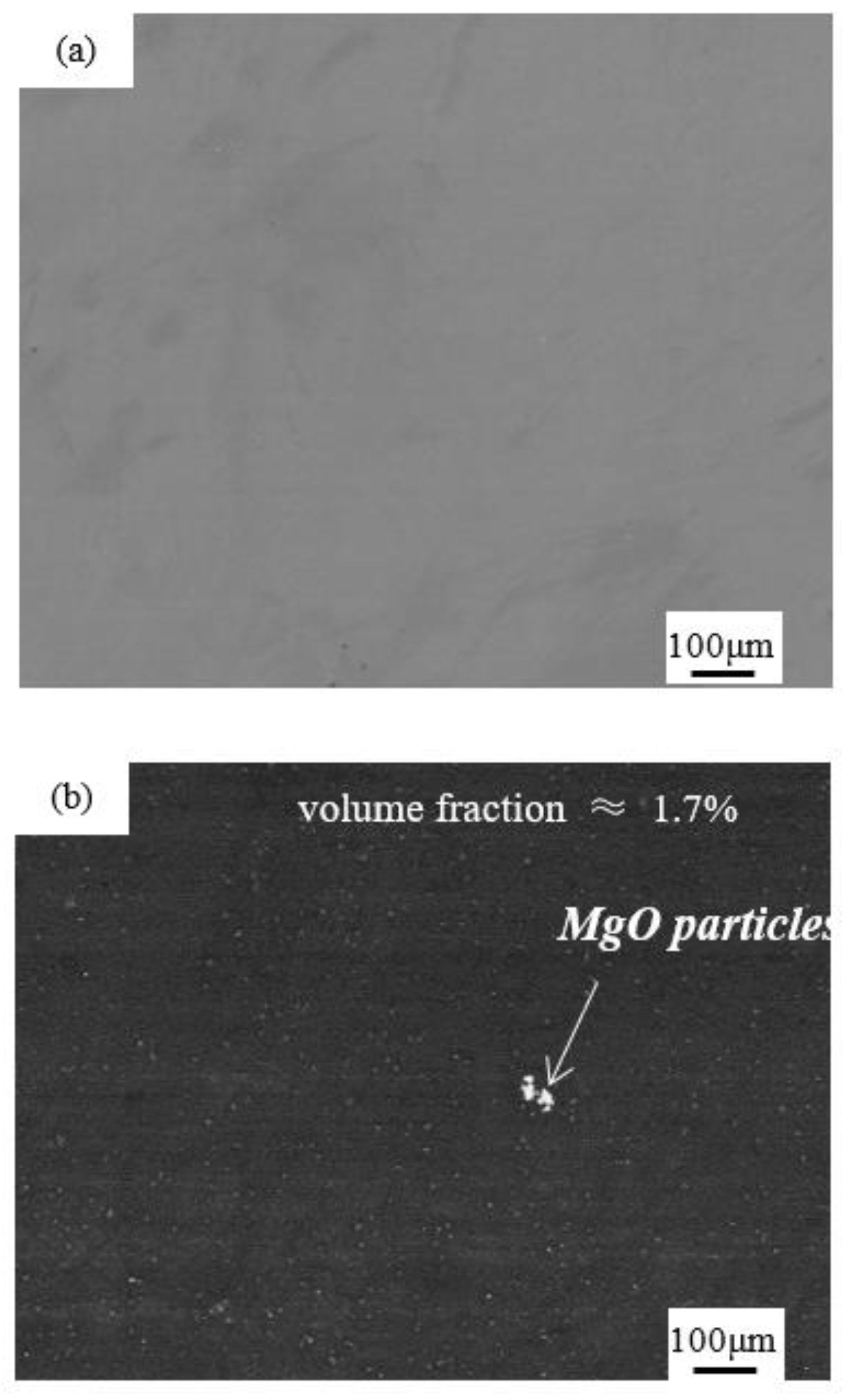
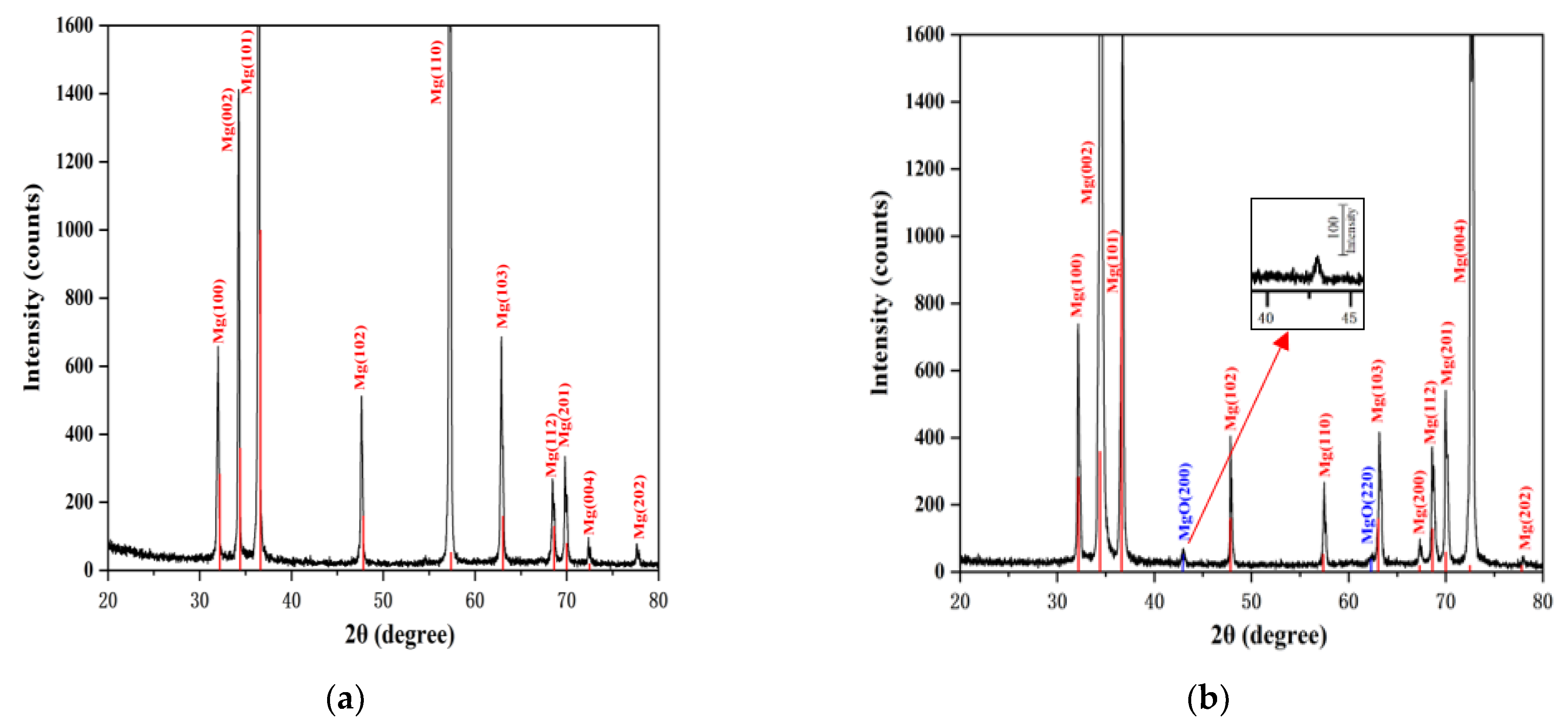

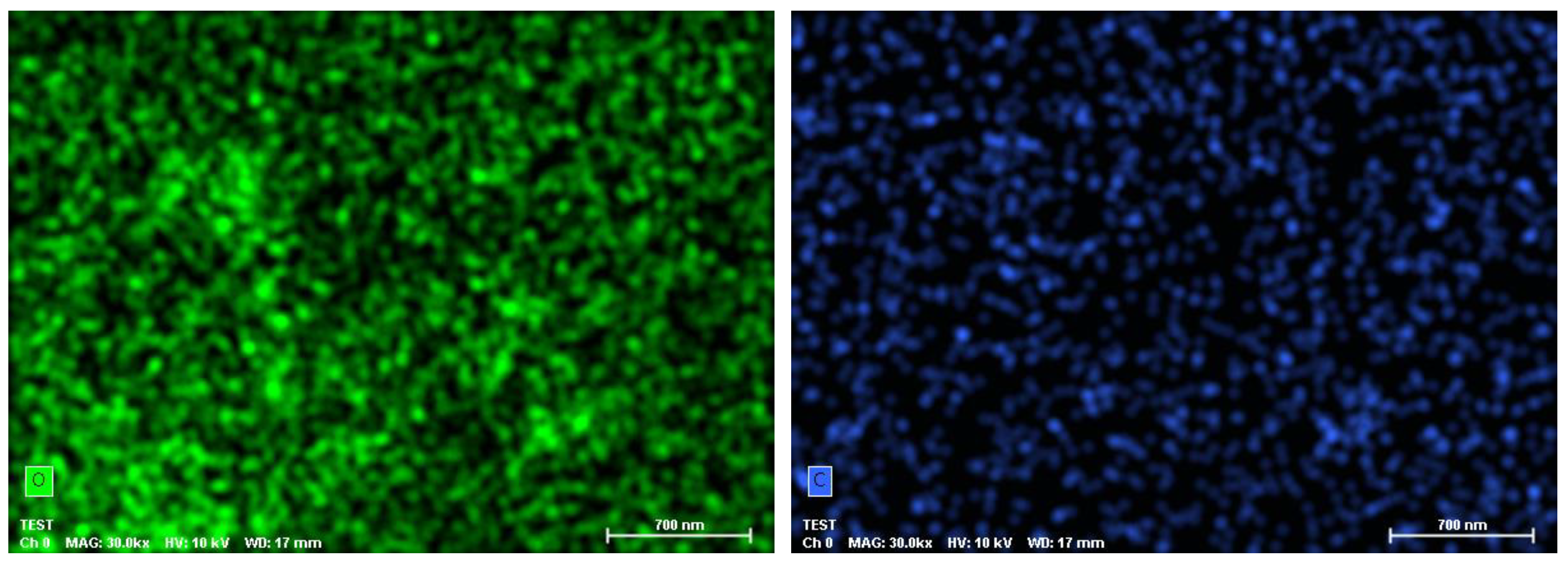
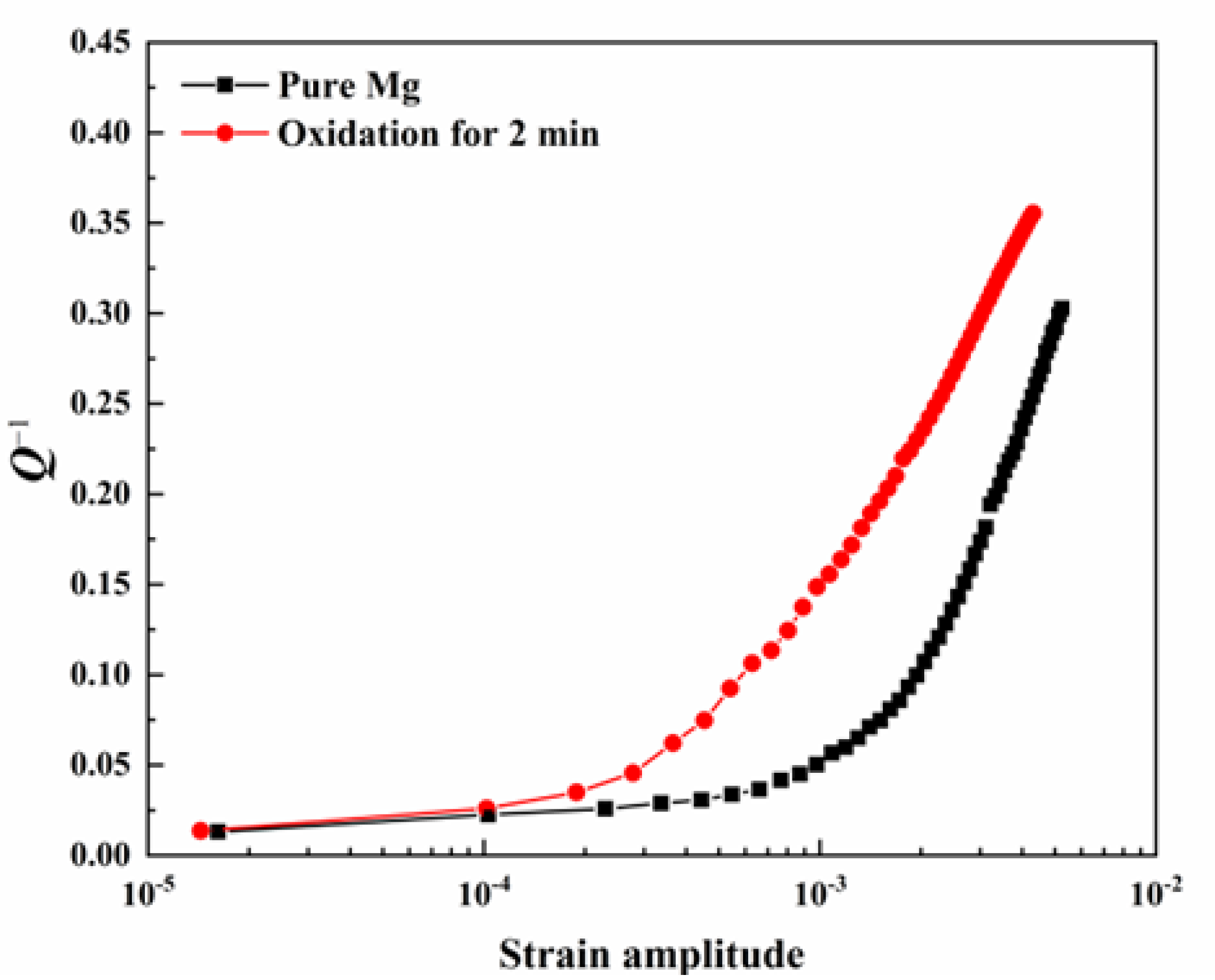
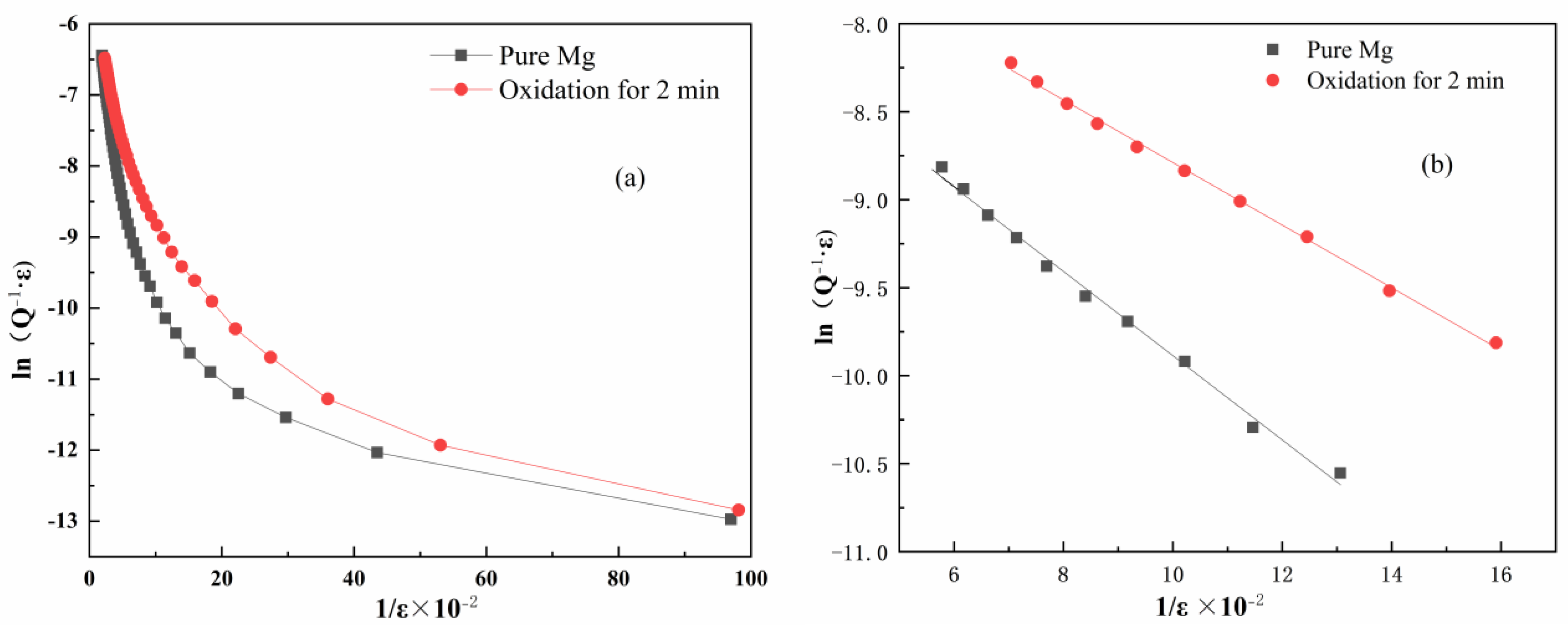
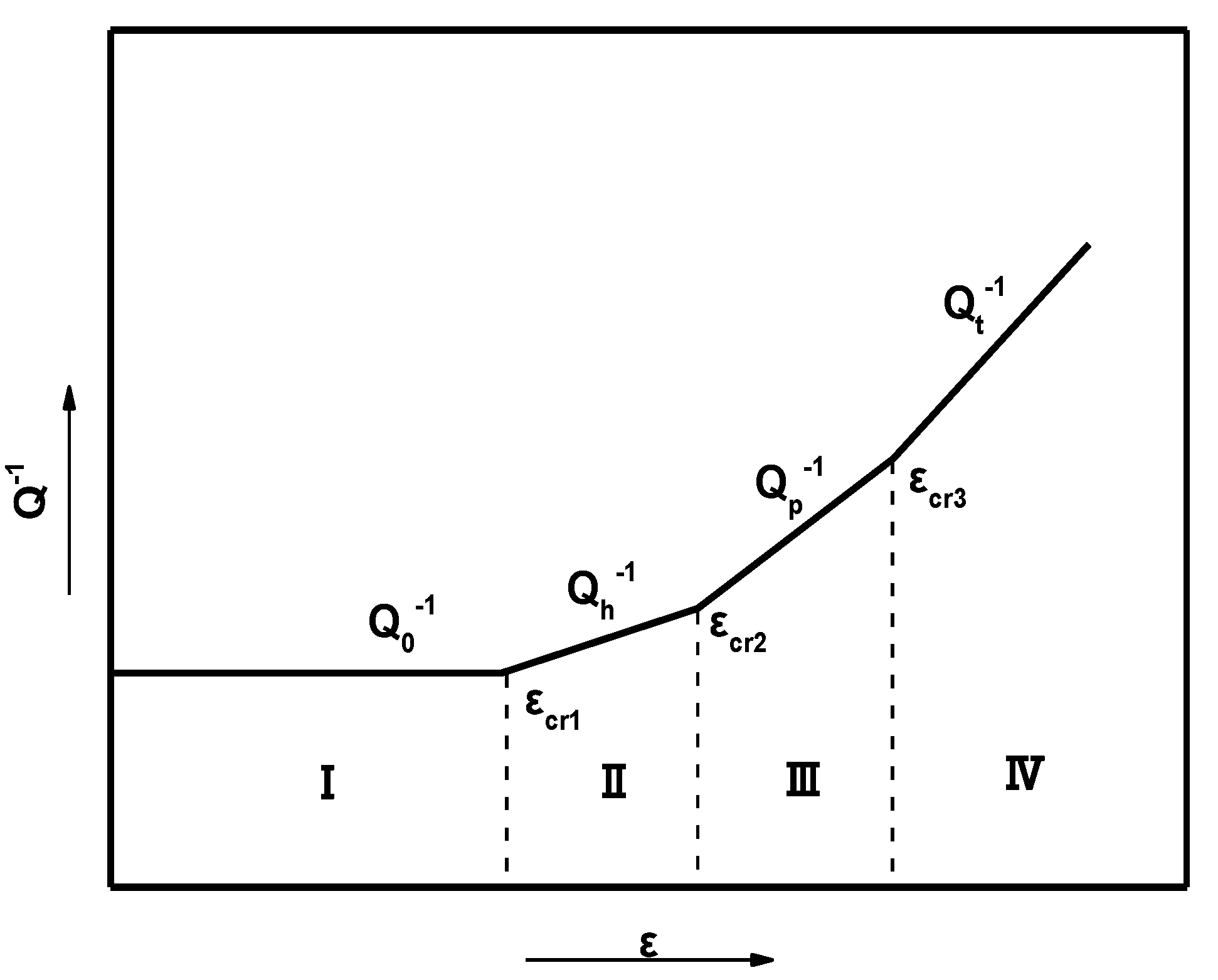
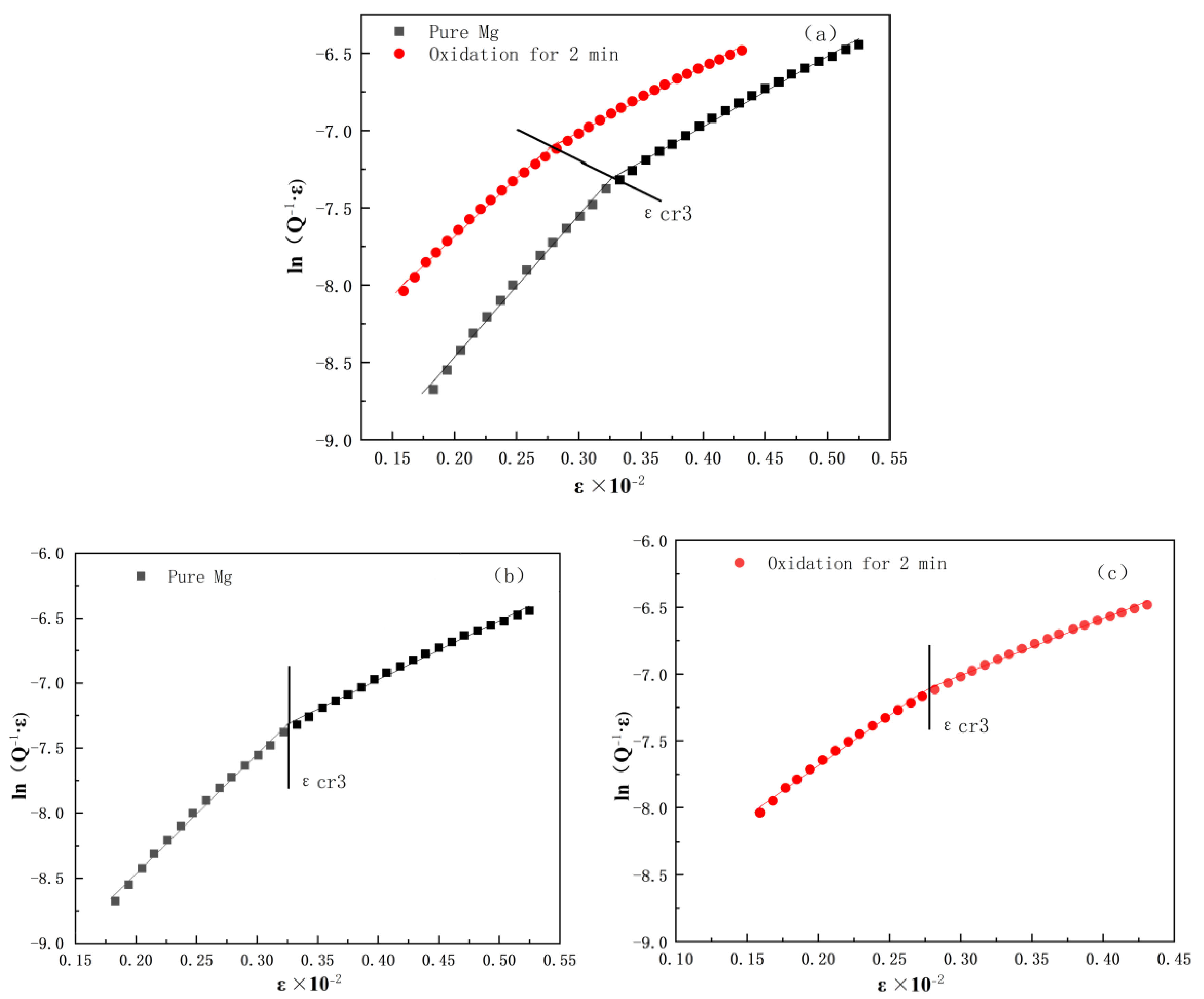
| Various Values | B1·102 | B2·102 | ·10−2 | |
|---|---|---|---|---|
| Material Type | ||||
| Pure Mg | 7.5272 | 4.2431 | 0.2875 | |
| Oxidation for 2 min | 9.1827 | 4.5476 | 0.3020 | |
Disclaimer/Publisher’s Note: The statements, opinions and data contained in all publications are solely those of the individual author(s) and contributor(s) and not of MDPI and/or the editor(s). MDPI and/or the editor(s) disclaim responsibility for any injury to people or property resulting from any ideas, methods, instructions or products referred to in the content. |
© 2023 by the authors. Licensee MDPI, Basel, Switzerland. This article is an open access article distributed under the terms and conditions of the Creative Commons Attribution (CC BY) license (https://creativecommons.org/licenses/by/4.0/).
Share and Cite
Wan, D.; Yang, F.; Hu, J.; Dong, S.; Tang, H.; Wang, Y.; Xue, Y.; Han, G.; Kang, J.; Xu, J.; et al. Damping Analysis of High Damping MgO/Mg Composites in Anelastic and Microplastic Deformation. Metals 2023, 13, 445. https://doi.org/10.3390/met13030445
Wan D, Yang F, Hu J, Dong S, Tang H, Wang Y, Xue Y, Han G, Kang J, Xu J, et al. Damping Analysis of High Damping MgO/Mg Composites in Anelastic and Microplastic Deformation. Metals. 2023; 13(3):445. https://doi.org/10.3390/met13030445
Chicago/Turabian StyleWan, Diqing, Fan Yang, Jiajun Hu, Shaoyun Dong, Hao Tang, Yu Wang, Yandan Xue, Guoliang Han, Jie Kang, Jingwen Xu, and et al. 2023. "Damping Analysis of High Damping MgO/Mg Composites in Anelastic and Microplastic Deformation" Metals 13, no. 3: 445. https://doi.org/10.3390/met13030445
APA StyleWan, D., Yang, F., Hu, J., Dong, S., Tang, H., Wang, Y., Xue, Y., Han, G., Kang, J., Xu, J., & Zeng, G. (2023). Damping Analysis of High Damping MgO/Mg Composites in Anelastic and Microplastic Deformation. Metals, 13(3), 445. https://doi.org/10.3390/met13030445






